The effect of seal-safe pinger sounds on wild Harbour porpoises (Phocoena phocoena)
Background

More than 300 000 specimen of small species of cetaceans are found dead in gill nets each year, including one of the smallest species of cetaceans living in northern cold waters, the harbour porpoise (Phocoena phocoena).
Acoustic deterrent devices, also known as “pingers” has worked as a very good solution that has reduced the number of by-catch in several species of cetaceans. The pingers are attached to gill nets and transmit sounds to deter Harbour porposies from areas where gill nets have been deployed.
In the past twenty years Swedish fisheries have experienced severe problems with seals damaging their fishing nets. Former studies have found that the increased population of seals in Swidish waters is the reason for the increased depredation of fishing nets. Another reason for the destroyed fishing nets may be due to the sounds of pingers. Several studies have showed that pinger sounds have a “dinner bell” effect that attract different species of seals.
Aim
A combination of increased populations of seals and the use of pingers in Scandinavian waters has lead to financial loss for fisheries as well as an increase in bycatch of harbour seals and grey seals. Therefore, the aim of this study was to investigate if harbour porpoises would avoid pinger sounds after the pinger had been adjusted to that they are inaudible to grey seals and harbour seals. Furthermore, a second aim of the study was to examine whether or not harbour porpoises would habituate to the new frequencies of the pinger.
Material and methods
Experimental set-up
Pinger and C-POD
The pinger used in this study was the AquaMark 2246 prototype “seal safe” pinger. The pinger randomly transmitted eight different sounds with frequency spectra between 60 kHz to >100 kHz every 5 to 30 second. To mimic the presence and abundance of fisher nets the pingers was adjusted in a 60-hour ON, 60-hour OFF schedule.
To monitor the presence of harbour porpoises, acoustic data loggers (Continuous Porpoise Detectors), also known as C-PODs were used. The C-PODs recorded the echolocation activity of the harbour porpoises, and this was used as a proxy for harbour porpoise presence.
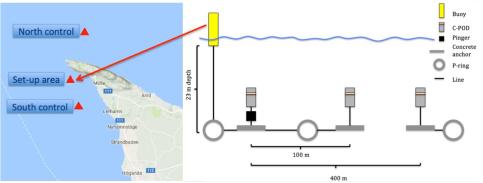
Set-up
Three C-PODs were deployed at in the set-up area at three different distances from the pinger. The first C-POD was deployed just above the pinger, while the other two were deployed 100 and 400 meters, respectively, from the pinger.
Additional two C-PODs were deployed south and north of the set-up area as controls.
Data analyses
The data from the C-PODs were analysed by using the custom-made software CPOD.exe, version 2.044. The data having a high probability to be from harbour porpoises were then exported as Detection Positive Minutes (DPM), which gives a relative measure of harbour porpoise presence. A DPM indicates, by logging click trains, that one or more harbour porpoises have been present during that specific minute. The number of DPM per logging hour was used for the further analysis, which was carried out in Excel. The data was divided into 60-hour pinger-on and pinger-off intervals.
Results
Significantly more DPM/h were found when the pinger was OFF in comparison to when it was ON for all positions except for the North control were no significant difference was found.
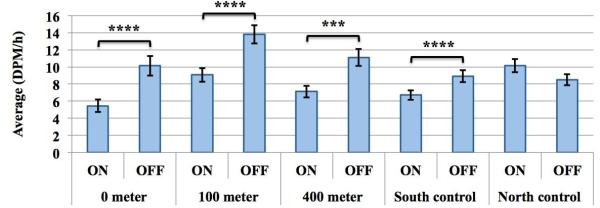
Habituation
No significant regression of the average (DPM/h) and the dates included 24 hours recording consecutively when the pinger was ON was found at 0 meters from the pinger (Linear regression test, 0 meter from the pinger P(0.107 ) ≥ 0.05, r= 0.329). However, a positive regression of the average (DPM/h) and the dates included 24 hours recording consecutively when the pinger was ON was found at 100 meters from the pinger, 400 meters from the pinger, south control and north control (Linear regression test, 100 meters from the pinger P(0.027 ) < 0.05, r= 0.355); 400 meters from the pinger P(0.0009 ) < 0.05, r= 0.432; South control P(0.039) < 0.05, r= 0.327; North control P(0.006) < 0.05, r= 0.453).
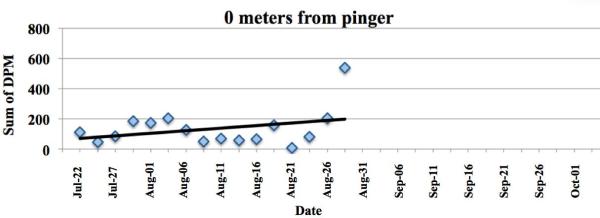

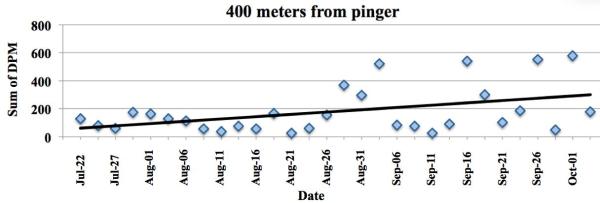
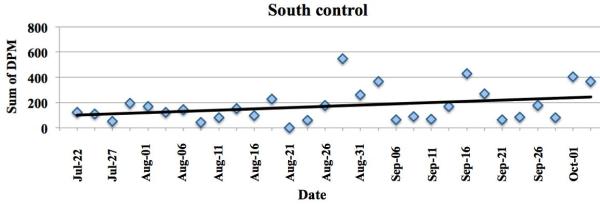
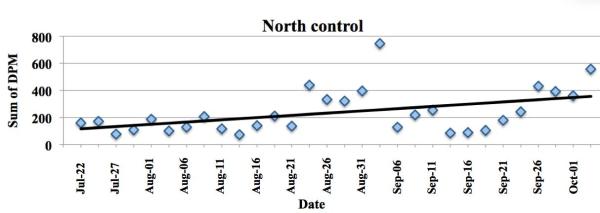
Conclusion
This study showed that harbour porpoises avoid the area where the pingers with frequencies inaudible to harbour seals and grey seals were deployed. Although due to the results from the south control, which position could not been affected by the pinger, this study can not establish whether or not harbour porpoises avoid the pinger sounds or if additional factors changed their behaviour during the times when the pinger was ON. Whether or not harbour porpoises habituate to the new pinger sounds has not been fully established since the presence of harbour porpoises also increase over time in the control areas.
Responsible for this page:
Director of undergraduate studies Biology
Last updated:
05/19/17
